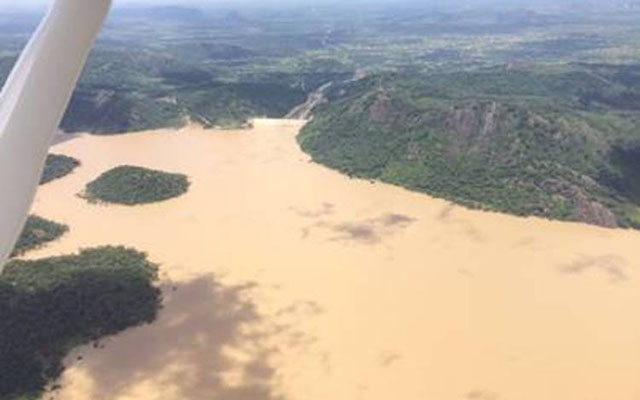Get rid of the silt – Agro-ecology expert

Jeffrey Gogo Climate Story
WHEN Cyclone Dineo rammed Masvingo earlier in the year, floods unleashed a glut of silt on Tokwe-Mukosi, the biggest in-land dam built in post-colonial Zimbabwe, rivalled only in size and capacity, and in everything else, by Kariba on the border with Zambia.
“The muddy water rushed through into the dam at high speeds, creating a reservoir “brown water full of silt, wonderful crop growing silt or soil on which grass for livestock grows that had run off with all the rains,” said Harare agro-ecologist, John Wilson.
Tokwe-Mukosi stands at 90m tall, occupying a surface area of 96 square kilometres.
It has a holding capacity of 1,8 billion cubic metres, which can irrigate 25 000 hectares. The dam was completed in December last year at a cost of $260 million.
But pictures of the dam in the aftermath of a devastating flood earlier in the year show that the dam might have been trapping sediment – that fine soil or other material washed away by running water – which ends up at the bottom of the dam, and is permanently blocked from moving downstream.
Now, without sounding alarmist, silt could become a major talking point at Tokwe-Mukosi going forward, moreso at a time when the frequency and intensity of such siltation events on are the rise country-wide.
For example, a succession of droughts have often times depleted water levels at Lake Chivero, a key source of drinking water for Harare, and irrigation for farmers on the outskirts of the capital.
But siltation has made things worse. The lake’s capacity has shrunk one fifth in the last 60 years, the Environmental Management Agency says.
No one knows really how much silt lies behind Tokwe-Mukosi in its infancy, and whether engineers that designed the dam have any special traps to rid the dam of excessive sediment in the future. But there is still time to get things right.
Mr Wilson laments that smaller dams could fill up fast with silt, impeding irrigation of most food crops such as maize or sorghum. Such dams are “only good for growing bananas.” he argues.
But he has a plan. “In these days of huge top soil loss, which we can’t stop in the short term, it would be much better to build dams in stages,” Wilson told The Herald Business, by email.
“(This way) the silt goes over the top of the one metre (then two metre etc) wall and leaves coarse sand behind; then one ends up with a dam full of coarse sand, which stores water well, and not silt.
“You can pump water out of that (coarse sand), but you can’t pump water out of silt.”
Water as a force
It is clear the brownish water colour at Tokwe-Mukosi was a direct result of the dumping of fine soil into the dam due to too much rain falling in a summer season now coming to a close.
Many water bodies tend to change colour after the rains anyway, which returns to normal within days, sometimes even hours.
Is there a chance this is what might have happened at Tokwe-Mukosi?
“Yes,” Wilson emphasised. “It does change colour as the silt settles down to the bottom of the dam.”
So, what’s the issue then?
“The problem is the loss of soil that all this reflects. Hundred and fifty years ago nearly all the water would have sunk into the ground where the rain falls feeding grasses and trees and then feeding underground water which in turn fed streams and rivers with clean water,” he explained.
Wilson is convinced that a more sustainable way of managing water will curb both water loss and sediment trapping in dams.
He said: “There doesn’t need to be run-off water except off very hard surfaces like rocks and roads and roofs etc, and then we need good water harvesting close to these to sink the water into the ground.
“Water in the ground is a positive force. Water running off above the ground is a negative force, as simple as that.
“All our practices should be geared towards getting water into the ground.”
At Tokwe-Mukosi, it will be impossible to rid the dam of all silt unless it was dredged – clearing out the base of the dam of any such things as mud or garbage.
Because of its size, it will be a long-time before the dam fills up silt, but there is a price to pay.
“Its (Tokwe-Mukosi) holding capacity of water (which is what it was built for, not to hold silt) will go down as the years go by which means that the investment put into it is being lost,” Wilson warned.
Several smaller dams, which have cost quite a bit to build, have silted up, making it difficult to pump water from them.
Not only does this impact negatively on agriculture, but also cost authorities money de-silting the water bodies.
According to Environment Minister Oppah Muchinguri Kashiri, the biggest causes of siltation were streambank cultivation, deforestation, alluvial mining, settling on wetlands and poor land management, she said in previous Press reports. Mazowe, Gwayi, Runde and Umzingwane are some of the badly affected dams.
“This is really about making the best from a bad situation. At the same time efforts should be made to stop the run off water,” said Mr Wilson.
God is faithful.












Comments